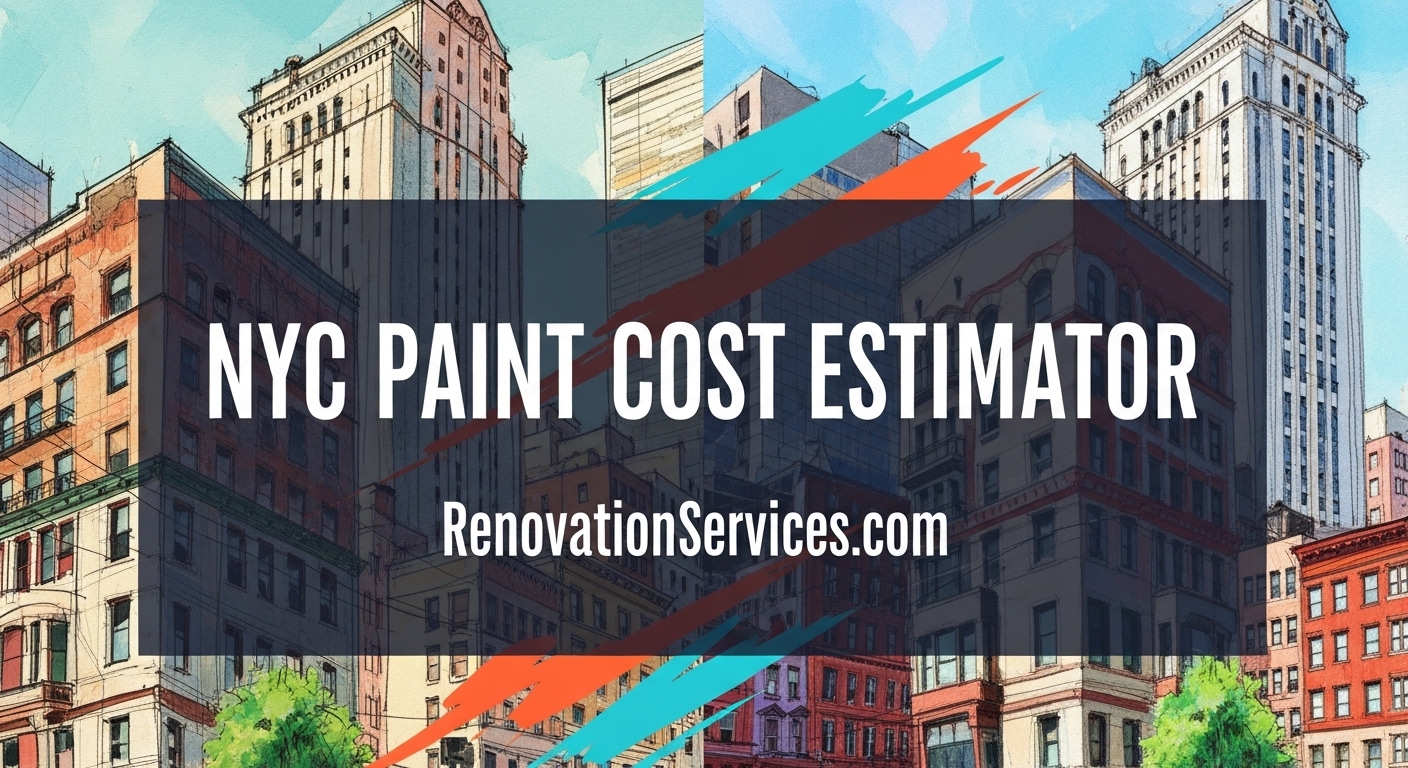NYC Paint Cost Calculator
Planning to repaint your apartment in New York City? The first question on your mind is likely: "How much is this going to cost?" Using a paint cost estimator is a great start, but NYC has unique factors that generic calculators miss. This in-depth guide breaks down every variable, from labor rates in Brooklyn to the cost of premium paint for a Manhattan high-rise, helping you budget accurately for a stunning result.
The 5 Core Factors of Your Painting Cost
Before diving into specific numbers, it's crucial to understand the key variables that professional painters consider when creating a quote. These five elements are the building blocks of any accurate paint cost calculator for the NYC market.
Factor 1: Labor Costs (The Biggest Driver)
In a high-skill market like New York City, labor is the most significant portion of your painting budget, often accounting for 70-85% of the total cost. This isn't just for applying paint; it covers the meticulous, time-consuming work that ensures a durable, flawless finish. This includes protecting your home, extensive surface preparation, and detailed cleanup. A painter's experience, efficiency, and quality of work are what you're primarily paying for. As we detail in our article on understanding labor charges, a higher rate often means a better, longer-lasting job.
Factor 2: Size and Scope of the Project
This seems obvious, but it's more nuanced than just square footage. Painters calculate the "paintable area," which includes all walls and ceilings. However, the scope also includes other elements that add time and complexity, such as trim (baseboards, crown molding), windows, and doors. Painting trim is detailed work that significantly adds to the labor hours compared to just rolling walls.
Factor 3: Condition of the Surfaces
The current state of your walls is a massive cost variable. A new construction condo in Long Island City with pristine, pre-primed walls will be far less expensive to paint than a pre-war apartment in Brooklyn Heights with cracking plaster and layers of old paint. The more prep work required, the higher the cost. This includes:
- Patching nail holes and small dings.
- Repairing larger drywall holes or cracks.
- Addressing water damage stains (which requires special primers).
- Wallpaper removal and wall smoothing.
- Skim coating to smooth out heavily textured or damaged walls.
Factor 4: Type and Quality of Paint
The cost of paint itself can range from $30 per gallon for basic contractor-grade paint to over $100 per gallon for premium or designer brands. While it might be tempting to save money here, high-quality paint is almost always worth the investment. It provides better coverage (requiring fewer coats), a more durable and washable finish, and richer, truer colors. The cost of materials, including primers, tape, and plastic, will typically make up 15-30% of the total project cost.
Factor 5: Architectural Complexity
A simple, box-shaped room is straightforward to paint. However, features common in NYC homes add considerable time and therefore cost:
- High Ceilings: Anything over the standard 8 feet requires ladders or scaffolding, slowing down the process.
- Intricate Details: Crown molding, chair rails, picture frame molding, and built-in shelving all require extensive, precise brushwork.
- Number of Windows and Doors: Each one needs to be carefully "cut in" (painted around the edges), which is time-consuming.
Pro Tip: The Prep Work is the Real Work
When comparing quotes, ask for a detailed breakdown of the preparation process. A lower bid might skimp on prep (e.g., minimal sanding, no priming), which will lead to a finish that fails prematurely. A quality job includes thorough cleaning, patching, sanding, and priming.
A Detailed Cost Breakdown for NYC Apartments
Let's translate these factors into real numbers. The following table provides a more detailed estimate for a standard professional paint job in NYC, assuming walls are in decent condition and using quality mid-range paint. These figures typically include walls, ceilings, and standard trim for the listed rooms.
| Apartment Size / Room | Estimated Price Range | Common Scope of Work |
|---|---|---|
| Studio Apartment (approx. 400-600 sq ft) | $1,800 - $3,500 | Main living area, kitchenette walls, bathroom. |
| One-Bedroom Apartment (approx. 600-850 sq ft) | $2,800 - $5,500 | Living room, bedroom, hall, kitchen, bathroom. |
| Two-Bedroom Apartment (approx. 850-1200 sq ft) | $4,500 - $8,500+ | Living room, 2 bedrooms, hall, kitchen, bathroom. |
| Just a Single Room (e.g., Bedroom) | $600 - $1,200 | Walls, ceiling, and trim for one average-sized room. |
| Accent Wall Only | $250 - $500 | Includes prep and two coats on a single wall. |
Pro Tip: Budget for Contingencies
Always add a 10-15% contingency fund to your final budget. Unexpected issues, like discovering hidden drywall damage after moving a bookcase or deciding to add an extra accent wall mid-project, are common in NYC renovations. Having a buffer prevents financial stress.
The "Hidden" Costs of a NYC Paint Job
A reliable paint cost estimator must account for factors unique to New York City that can impact the final price. These are often overlooked in online calculators.
- Parking and Logistics: In many parts of Manhattan and dense Brooklyn neighborhoods, parking a work van for the day can cost a contractor $50-$100 or more. This cost is often factored into the project's overhead.
- Co-op/Condo Building Rules: Many buildings have strict rules about work hours (e.g., 9 AM to 4 PM only), require contractors to use service elevators, and demand extensive floor and hallway protection. These limitations can extend the project timeline, increasing labor costs.
- Extensive Drywall & Plaster Repair: What looks like a simple crack could be a sign of a larger issue. Repairing significant water damage, fixing crumbling plaster in a pre-war building, or addressing a peeling bathroom ceiling properly requires more than just a bit of spackle.
- Lead Paint Abatement: If your building was constructed before 1978, there's a high chance of lead paint. Federal and NYC laws require certified professionals to handle its removal or encapsulation safely, which is a specialized and more expensive process.
- Wallpaper Removal: This can be a project in itself. Old wallpaper that was applied incorrectly can be extremely difficult to remove and often damages the wall underneath, requiring significant skimming and repair before painting can even begin.
Pro Tip: Discuss Building Logistics Upfront
Before hiring, ask your contractor how they handle building logistics. Inquiring about their plan for parking, material delivery, and adhering to co-op work hours can prevent surprise delays and costs down the line. A seasoned NYC contractor will have this process down to a science.
DIY vs. Hiring a Professional Painter in NYC
Thinking of saving money by doing it yourself? It's a valid consideration, but it's important to weigh the true costs. We explore this in depth in our article on DIY vs. hiring a professional.
The DIY Cost Breakdown
For a standard one-bedroom apartment, your materials might cost:
- Paint & Primer: $200 - $400 (for quality products)
- Tools: $100 - $200 (brushes, rollers, trays, tape, drop cloths, pole sander)
- Your Time: This is the biggest cost. A professional crew might paint a one-bedroom in 2-3 days. For a DIYer working on weekends, it could easily take 2-3 full weekends (40+ hours) to do a proper job, including all the prep and cleanup.
When to Hire a Professional
A professional painter brings more than just a brush. You're paying for:
- Speed and Efficiency: They can complete the job in a fraction of the time.
- Professional-Grade Tools: They have everything needed for any situation, from sprayers for a perfect cabinet finish to advanced dust-extraction sanding systems.
- Expertise: They know exactly how to prep different surfaces, how to troubleshoot problems, and how to achieve a finish that will last for years.
- Insurance: A professional contractor is insured, protecting you from liability for accidents or property damage.
Pro Tip: The Value of Your Time
Consider the value of your free time. If spending three weekends prepping and painting means missing out on family time, relaxation, or other important activities, the cost of hiring a professional often provides immense value beyond the financial calculation.
Getting a Rock-Solid, Accurate Painting Quote
To use any paint cost calculator effectively and compare apples to apples, you need to get detailed, professional quotes. Here’s how to ensure you get one.
- Insist on an In-Person Walkthrough: Never accept a quote over the phone or email based on square footage alone. A true professional will need to see the condition of the walls, the complexity of the space, and discuss your goals in person.
- Request a Line-Item Breakdown: A professional quote should not be a single number. It should clearly separate the costs for labor and materials. It should also specify the exact type of paint and primer to be used (brand and product line).
- Clarify the Scope of Prep Work: The quote must explicitly state what preparation is included. Does it cover just minor nail holes, or does it include repairing larger cracks and sanding all surfaces?
- Discuss the Cleanup Process: Confirm that the quote includes a thorough cleanup and returning all furniture to its original position.
- Ask About Their Team: Are they using employees or subcontractors? Are all workers covered by their insurance?
Pro Tip: Ask Specific Questions When Checking References
When you call a contractor's references, go beyond a simple "Were they good?" Ask specific, insightful questions like: "Was the project completed on time and on budget?" "How did the crew handle cleanup at the end of each day?" "Were there any unexpected issues, and how were they resolved?" This will give you a much clearer picture of their professionalism.
Local Cost Nuances Across the Boroughs
While the core costs are similar, there can be slight variations and different challenges depending on your location.
- Manhattan: Costs can be highest here due to building logistics (parking, service elevators, strict work hours in co-ops on the Upper East Side) and the high demand for top-tier, flawless finishes in neighborhoods like Tribeca and Chelsea.
- Brooklyn: A highly varied market. A painting job in a Park Slope brownstone with extensive plaster repair will cost more than painting a new construction apartment in Bushwick.
- Queens: Often offers slightly more competitive pricing due to easier logistics. However, jobs in luxury buildings in Long Island City will command prices similar to Manhattan. Our Queens services cater to this wide range.
- Staten Island & The Bronx: Generally, these boroughs may have slightly lower labor rates due to less congestion and easier access, though the quality of the contractor remains the most important factor in the final price.
Pro Tip: Look for Hyper-Local Expertise
When selecting a contractor, look for one with a strong portfolio in your specific neighborhood. A painter who intimately knows the co-op boards in the Upper East Side or the challenges of historic brownstone plaster in Park Slope brings invaluable local experience that can save you time and money.
Ready to Get Your Exact Project Quote?
While this guide and our paint cost estimator provide a strong foundation for your budget, the only way to know the true cost is with a detailed, professional estimate. Don't leave your home's transformation to guesswork.
The team at RenovationServices.com provides comprehensive, in-person consultations to give you a precise and transparent quote for your painting project. We serve all five boroughs and Long Island.
Call Us for a Free, No-Obligation Estimate Email Our Team to Schedule a Walkthrough






